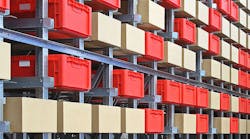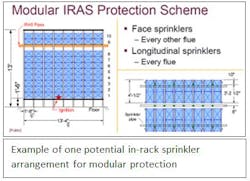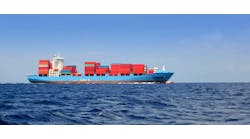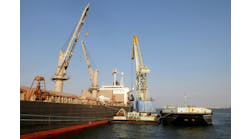A robotic material handling unit (i.e., a robot) zips through a global toy manufacturer’s six-story distribution center. As the unit retrieves an open-top plastic container filled with freshly molded toy planes from an automatic storage and retrieval system (ASRS), sparks from a frayed electrical cable on the robot fly everywhere, igniting both the toy planes and the plastic container in which they are stored.
Due to the high concentration of combustibles, flames quickly spread through the rack, involving more plastic and cardboard containers filled with toys that kids dream about.
Ceiling sprinklers activate, but by then the fire has spread across aisles arranged as narrowly as possible to maximize storage space. The ASRS’s steel racking structure that holds tens of thousands of toys starts to warp and buckle from the heat. That framework, by the way, was supporting the roof….
Scenarios like these worry risk managers and warehouse managers alike as the risk of fire in automated warehouses grows. First, more warehouses are automating – using robots instead of humans to pick and pack orders for shipping. Secondly, automation is enabling warehouses to go higher and store goods more densely.
Not only do risk managers fear that a fire will destroy their inventory and interrupt their business, perhaps critically; they may also have more routine concerns:
- A lack of guidance on what they need for fire protection of these automatic storage arrangements.
- They don’t want to overspend on new fire protection.
- They especially don’t want to decrease their storage capacities – unless absolutely necessary.
Finding Answers
NFPA 13, Standard for the Installation of Sprinkler Systems, which is typically risk managers’ go-to source for fire protection guidelines, hasn’t weighed in yet on fire protection for automated warehouses; protection options for open-top containers are outside the scope of NFPA 13. Our team of researchers and engineers, however, has studied the fire protection challenge of automatic storage and retrieval systems for five years, and spent millions conducting large-scale fire tests, computer simulations and more than 200 water-flow tests.
The result? Evidence-based recommendations that help businesses to create optimal fire protection, and at a lower cost than previous recommendations for ASRS arrangements.
Understanding Automated Warehouses
Let’s look at how automated warehouses pose new risks.
In automated warehouses, while the containers may sometimes be cardboard or metal, goods are more often stored in plastic containers about the size of a household recycling bin. These containers burn much more severely than cardboard or wooden containers.
The containers themselves, no matter what material they’re made of, can also create problems with water flow down through the rack where the sprinkler water is needed. When they’re open-topped, as they often are, they collect sprinkler water and prevent it from cascading to lower tiers of burning product in a timely manner.
The rack structure itself can create a problem with water flow as well. Angle irons, which often hold the containers in place, can divert precious water away from the fire area.
Robots are more agile than people driving forklifts, so automated warehouses tend to optimize storage space by reducing the size of aisles – typically to 4 feet (1.2 meters) or less – as well as by minimizing the spaces between container loads, both horizontally and vertically.
While this arrangement increases storage efficiency, it also increases the ease with which fire can spread horizontally, not only within the rack of fire origin but also to adjacent racks due to the narrow aisle widths.
Get the Answers
Taking all this into consideration, the new guidelines in FM Global Loss Prevention Data Sheet 8-34 (PDF), Protection for Automatic Storage and Retrieval Systems (ASRS) can help risk managers and warehouse managers:
- Determine how fire protection in automated warehouses can be optimized based on the type of storage racks and containers chosen.
- Feel at ease that their fire protection systems will mitigate fire, water and smoke damage in the event of a fire.
- Keep fire protection systems as affordable as possible.
Think Modular
In-rack Sprinkler Arrangement
The type of storage rack (i.e., single-, double- or multiple-row) as well as the type of container will generally be the driving factors for the in-rack sprinkler arrangement. As an example, for a typical double-row rack using solid-walled plastic containers, Data Sheet 8-34 would recommend the installation of three rows of in-rack sprinklers for approximately every 10 feet (3.0 meters) of vertical increment. The three rows of in-rack sprinklers would generally be arranged as follows:
- At the face of each rack, in-rack sprinklers would be provided between every two containers (i.e., every other transverse flue space), and
- Within the longitudinal flue space (the space separating the backs of each rack), in-rack sprinklers would be provided between every container (i.e., every transverse flue space).
Other Considerations
Containers: Containers and their contents that are arranged to allow water to escape from them, near the bottom of the container’s sides perpendicular to the loading aisle, will allow for greater vertical distances between in-rack sprinklers. This would help decrease the cost of in-rack sprinkler installation and allow for greater storage capacity.
Racking structure: Many ASRS racking structures use angle irons to support container storage within them. Testing has shown that angle irons can divert sprinkler water discharge from the transverse flue spaces where the water is needed. Using ASRS racking structures that do not divert water from the transverse flue spaces can also allow for an increase in the vertical distance between in-rack sprinklers, which would reduce the cost of in-rack sprinklers and increase storage capacity.
Ceiling sprinklers: Even with the modular in-rack sprinkler approach, ceiling sprinklers are still needed. Testing has demonstrated that they can protect up to a maximum of 10 feet (3.0 meters) of storage above the top in-rack sprinkler level.
Horizontal barriers between tiers: Horizontal barriers, which are basically ceilings built within the storage racks constructed of either plywood or sheet metal, were previously recommended to limit fire spread as well as quickly activate in-rack sprinklers. With the new, enhanced fire protection, the costs and headaches associated with these barriers are eliminated as they are no longer required.
System independence: Fortunately, you don’t have to design ceiling and in-rack sprinkler systems to work in tandem. Independent sprinkler systems translate into reduced water flow requirements, which also translates into a reduction in cost for water supplies feeding the sprinkler systems.
Together, these recommendations help warehouse operators optimize their available storage capacity, reduce necessary water flow, and limit projected fire, smoke and water damage.
What This Means to Warehouse Managers
Hopefully, our multimillion dollar investment in research answers some of the vexing questions manufacturers are starting to ask. These questions only loom larger as more companies automate their warehouses, pack them more densely and stack products higher. Careful design and configuration can help ensure that fires are quickly suppressed and companies that do experience a fire stay in business and remain competitive.
Ultimately, the goal is to let robots, which in science fiction always seem to run amok, deliver the quiet efficiency they promise in the real world.
Weston Baker Jr. is staff vice president, senior engineering technical specialist, in the Engineering Standards Group at FM Global, one of the world’s largest commercial property insurers.




